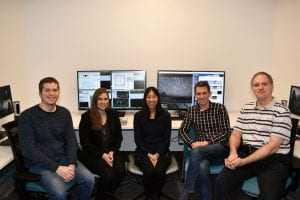The Sky is No Limit
By Lydia Rivers, Media & Events Aide (CIERA)
 From left: Peter Blanchard, CIERA postdoctoral fellow; Kerry Paterson, CIERA postdoctoral associate; Wen-fai Fong, Assistant Professor of Physics & Astronomy; Adam Miller, LSST Data Science Fellow and Data Science Fellowship Program director; Jason Pattie, user support specialist and Computational Facility manager
From left: Peter Blanchard, CIERA postdoctoral fellow; Kerry Paterson, CIERA postdoctoral associate; Wen-fai Fong, Assistant Professor of Physics & Astronomy; Adam Miller, LSST Data Science Fellow and Data Science Fellowship Program director; Jason Pattie, user support specialist and Computational Facility manager
Northwestern astronomers have begun scanning the heavens from Evanston using a newly completed remote observatory to link to the W.M. Keck Observatory in Hawaii. Located on the 13,600-foot summit of Mauna Kea, the twin 10-meter-wide telescopes provide a state-of-the-art celestial window for University researchers to collect astronomical data without needing to travel thousands of miles to do it.
“The fact that we now have a remote observatory puts us on another level in terms of observational astronomy,” said Wen-fai Fong, a core astronomy faculty member of Northwestern’s Center for Interdisciplinary Exploration & Research in Astrophysics (CIERA). “Now we can provide that service to our own observers, as well as other researchers from around the country. Given the rarity of such rooms, it’s extremely exciting to be able to share this new capability.”
CIERA astronomers have institutional access to the Keck telescopes in Hawaii and the MMT Observatory in Arizona. Northwestern’s new remote observatory is one of the only non-coastal remote observatories in the United States, providing a central hub for certified astronomers from around the country to collect data from these distant telescopes.
The remote observatory is located in CIERA’s Evanston facility, in a room with four powerful computers and accompanying monitors. Two monitors are used to directly control the instruments on the telescopes, while the others are used for observers to conduct video calls with the telescope operators who control the telescope’s actual movement. It may sound straightforward, but Fong says that each piece of hardware has been carefully selected for fail-safe observing. The CIERA set-up is designed to mirror what would be used even if an astronomer made the long trek out to the physical telescope sites.
“It is difficult to go all the way up to the summit to observe, so you actually observe in a remote room at the base of the mountain in Hawaii,” said Kerry Paterson, a CIERA postdoctoral associate who uses the telescopes to study distant galaxies that host cosmological explosions. “Even if I went to Hawaii, I would still be observing remotely. Instead of having to go all the way there to observe, I can do so from my home institute.”
Powerful and Efficient
Previously, Northwestern astronomers traveled across the United States to observe at Caltech, losing three days for a one-night observing run. For graduate students, a remote observatory at Northwestern makes it possible to gain early, hands-on training, without missing classes due to travel.
“Northwestern's access to world-class observatories like Keck and MMT was a major factor influencing my decision to come to Northwestern,” said postdoctoral fellow Peter Blanchard. “I am very excited to utilize CIERA's remote observing room to collect critical data supporting my research goals.”
In addition to convenience, astronomers can more easily observe targets of opportunity (ToOs). Northwestern receives three ToOs per semester, where astronomers are allowed to interrupt someone’s scheduled observation session for an hour to collect data on a particularly exciting phenomenon. According to Paterson, it is entirely unrealistic for most researchers to travel across the country to observe for an hour, so typically the scientists rely on another astronomer to observe the event for them.
Raffaella Margutti, an assistant professor of physics and astronomy, said that opportunities for the most exciting discoveries in time-domain astrophysics usually “come invited.”
“Time-domain astrophysics is the physics of the rapidly changing sky. The Universe decides for you and you can't plan in advance,” said Margutti. “This is why having ToO capabilities is key to realize the great discovery potential of this field of research."
Initially, astronomers will be observing at the new remote observatory about once a month. Because of the time difference between Evanston and Hawaii, sessions typically start around 11 p.m. CST and last about eight hours in the summer and up to 13 hours in the winter.
Preparation for remote observing sessions occurs far in advance; observing time is very expensive and highly sought after. To maximize viewing opportunities, astronomers carefully plan the targets they would like to observe, the instruments they would like to use, and the type of data they wish to collect.
“You cannot finish observing a target and then start thinking, what should I do next?” said CIERA postdoctoral associate Giacomo Terreran, who uses the Keck and MMT to study the behavior of supernova explosions. “You already have to know what's going to be the next target… Every second that you spend is extremely precious.”
The viewing astronomer is connected to an on-site telescope operator and chooses where to position the telescope, what instruments to use, and what data to collect by communicating with the operator who remains connected with them for the entirety of the observation.
“The hands-on experience that you get from controlling the instrument yourself, interfacing with a telescope operator, staying up through the night to take your own observations and making real-time adjustments is irreplaceable,” said Clifton Johnson, a CIERA postdoctoral fellow who uses the Keck telescopes to study star clusters.
CIERA astronomers are looking forward to a long future of flexible observing at home in Evanston, training students, and welcoming visiting scientists from other institutions.
“This arrangement is as practical as you can be if you cannot go and do experiments in the sky on the stars, but you can observe it and take data,” said Terreran. “This is the closest to experimental physics that you can get in astronomy.”